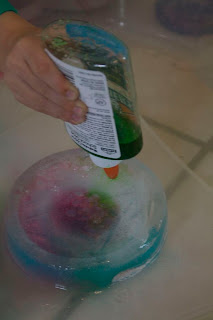This experiment ended up combining a couple activities. One was our original experiment to observe the affect salt had on ice; salt lowers the melting point of ice. To do this I took 4 little cups of colored water and added a different salt to each of them, table salt, kosher salt, sea salt, and rock salt. They were concentrated solutions with salt still visible at the bottom.
I froze water in a couple different sized containers and then provided a variety of tools for the girls to use to put the salt water on the ice.
I was hoping the colors would stay separate, so we could see when each solution went. Since it was all basically water, and all I had to color them with was food coloring it pretty much mixed together. You could definitely see how the salt water melted the ice pretty rapidly.
The more pressure with which the solution was applied (like with the nasal aspirator directly against the ice), the faster and deeper it melted.
The rock salt seemed to melt the ice the fastest when simply set on it, but no real measurements to actually say. The tunnels made by the salt were kind of pretty.
I had seen a post before about Musical Salt which used ice and salt to make noise. So before all our ice melted I decided to see if we could get ours to make some noise. I took table salt and dumped a bunch of it right on one piece of ice. Low and behold we had noise. It wasn't really music, but it was crackling as the ice was melting. I think it helped that the ice was already a bit melted which allowed the salt to get into already existing cracks and work faster.
I tried to repeat it with the other types of salt, but I didn't get near the about of crackling like I did the table salt. Perhaps the finer grain allowed it to get into the cracks better???
 |
| It is hard to see, but there is a pile of salt on the ice. |
I tried to repeat it with the other types of salt, but I didn't get near the about of crackling like I did the table salt. Perhaps the finer grain allowed it to get into the cracks better???



















